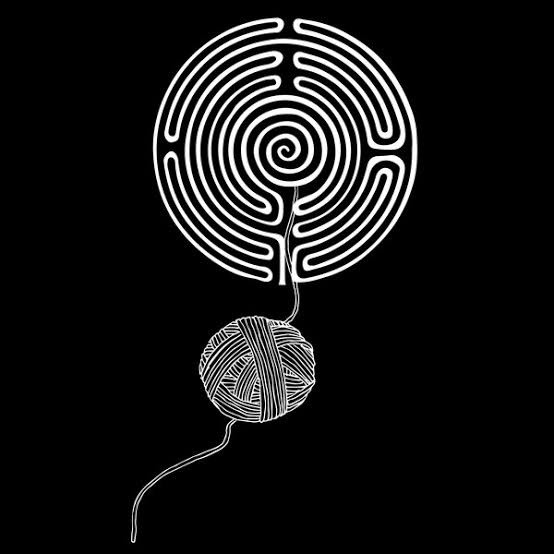"The Thread of Ariadne", which took its name from the myth of Ariadne, means nowadays the solution of a problem that at first seems unsolvable!
Myth is rich in metaphor that can illustrate and inform the creative journey. The story of the labyrinth from Greek myth is an excellent example of this. Sometimes the creative process can feel like we're walking a maze, getting lost along the way. What can this story teach us about both finding the center of the labyrinth and finding our way out again?
The story of the minotaur starts with Minos, who became king of Crete when Poseidon sent a great white bull out of the ocean as a sign Minos should rule. Minos had promised to sacrifice the bull to Poseidon, but broke his promise when he saw how beautiful the bull was, and sacrificed a lesser animal instead. Poseidon was angry when Minos broke his promise, so he punished him by making his queen, Pasiphae, fall in love with the bull. Out of this union the minotaur was born.
Minos instructed the great architect and engineer Daedalus to build the labyrinth to house the Minotaur. It was famous for being unnavigable; once in, anyone who entered was doomed to be eaten by the Minotaur. Minos then conquered Athens, and he demanded as tribute that every year Athens would send seven maidens and seven youths to be sacrificed to the minotaur.
Theseus, son of King Aegeus of Athens, volunteered to join the band of youths who were to be sacrificed. He traveled to Crete, and as soon as he arrived Ariadne, King Minos' daughter, fell in love with him. She offered to help him conquer the labyrinth and kill the minotaur if he would marry her and take her away from Crete. He agreed. Ariadne gave him a ball of red thread, and Theseus unrolled it as he penetrated the labyrinth, which allowed him to find his way back out. He found the minotaur deep in the recesses of the labyrinth, killed it with his sword, and followed the thread back to the entrance.

Theseus took Ariadne away from Crete, but then forsake his promise to marry her by abandoning her as she sleeps on the beach of the island of Naxos. She thinks she is about to die, but she is discovered there by the god Dionysus, who falls in love with her and makes her his wife, and was the only husband among the Greek gods to remain faithful to his wife.
This is perhaps one of the most unintuitive yet mightily profound aspects of Greek mythology.
The story does not start or end with the Minotaur, but he is at the heart of it, as he is at the heart of the labyrinth.
The first part of this story is that a monster must be slayed as part of the initiatory journey of following the path through the maze, but there is more to his presence than that. Monsters are often the guardians of treasure, who must be slain in order to bring the treasure out. In a creative journey, we must often find our way through a labyrinth. We take wrong turns, hit walls, get lost. Often, this is what must happen to find the creative treasure at the center of ourselves, that one thing that must be brought into the world through our creative efforts. That is the true magic of the creative life. The process of living creatively brings new things into the world and to humankind, but there is a monster guarding the gift, because when the maze "takes one to the center of one's self, to some hidden, inner shrine, occupied by the most mysterious portion of the human personality". This journey through the labyrinth must be hard. "The harder the journey, the more and the tougher obstacles in his path, the more the initiate will be transformed and acquire a new self in the course of the voyage of initiation."
In our inner labyrinths, the Minotaur fulfils a necessary guardian role; a part of ourselves that needs to be conquered in order to create. What in us has to be slain before we can bring our creative work to life?
The other part of this story is the role of Ariadne in the story. In fact the true hero of this story is Ariadne, not Theseus, and it is her we must look to for the wisdom in the myth. She is the one who chooses Theseus when he arrives in Crete, using him as a tool to escape the island. She is clever enough to come up with a way for Theseus to find his way out of the labyrinth. She is really the one who defeats the labyrinth; Theseus is merely her method for doing so.
Her ball of red thread is an excellent metaphor for that cleverness, as well as for the intuition which guides her in creating such a simple solution to the problem of the labyrinth. We can use our own thread to find our way through to the heart of the maze.
Thus, if everyone realises by their experience what is their Ariadne’s thread, what is their motivation or intent and what is their means to the end, the labyrinth’s monstrosity perhaps diminishes.

Ariadne’s Thread is the thread of divine connection, the thread that leads us HOME.
@ Yeshwant Marathe
yeshwant.marathe@gmail.com
Thanks to Prashant Naik for the initial input

